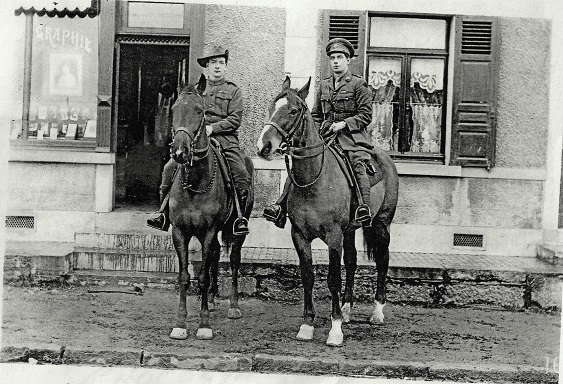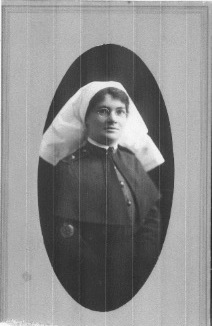
Some of the information on this page was collated by Lyn Hedger, who has kindly given her permission to reproduce this text. Other information has been copied from the war service histories available at the National Archives of Australia website, and the Australian War Memorial's site (www.awm.gov.au).
William Gray Dixon Robertson, known as 'Robbie' and also 'Billy', was born at Barrabool, near Geelong, on 30 March 1895, the fourth of 9 children born to the Rev Colin and his wife Margaret (Gray Dixon) Robertson.
Robbie enlisted in the Army on 18 January 1915 at Geelong. At the time, he was a farming student at Sparrovale Farm, near Geelong. Robbie was directed to Broadmeadows Camp where in March 1915 the 13th Light Horse Regiment was raised, the 3rd in Victoria for the Australian Imperial Force (AIF). The Regiment was made up of 25 Officers and 497 Other Ranks (OR). Most of the solders were in their 20s so Robbie, at 19, was in the minority. He was promoted to Corporal on 29 March 1915. All Australian Light Horse Regiments were armed with rifles and almost exclusively mounted on Australian Waler horses.
Before departure overseas, the Regiment marched through the streets of Melbourne to the docks at Port Melbourne. Their horses were led into the sea and then up ramps and into the hold of the ship, where they were confined, standing, in narrow stalls for the duration of the voyage.
The Regiment sailed for Egypt on board the HMT A34 Persic on 28 May 1915, a bit over one month after the first Australian landing at Gallipoli. The horses needed constant care from the solders during the month long trip as they were in danger of injuring themselves on the rails that divided them from the other horses, particularly in rough seas.
On arrival in Egypt, the regiment underwent extensive training as their initial training in Broadmeadows had been quite basic. The Regiment called themselves 'The Devil's Own', a reference to the number 13, and had badges made in Egypt featuring a dancing devil and a pitchfork.
The Regiment was called to relieve the exhausted soldiers on the Gallipoli Peninsula, landing on 11 September 1915. The men were disappointed to find that their horses were to remain in Egypt while they were in Gallipoli. They had expected to fight the war on horseback; dismounted, trench warfare was a very different situation and extremely gruelling. The Regiment remained at Gallipoli for four months, most of the time manning the trenches at Lone Pine. Robbie was evacuated by hospital ship to Malta in late 1915, suffering from influenza and conjunctivitis.
On recovery, Robbie was transported back to Egypt where he rejoined his Regiment that had returned from Gallipoli. The Regiment helped to defend the Suez Canal. In Egypt the 13th Light Horse was broken down to provide a divisional cavalry squadron for the 2nd, 4th and 5th Divisions. These squadrons proceeded to France with their divisions in March and June 1916.
'Robbie's squadron left Alexandria on 17 March 1916, arriving in Marseilles on 23 March 1916. The various Australian Regiments were reformed in July 1916 and renamed the 1st ANZAC Light Horse Regiment. According to this Australian War Memorial page, 'the 13th Light Horse carried out traffic control, rear area security and prisoner escort tasks, and, when the tactical situation permitted, the more traditional cavalry role of reconnaissance'.

An undated photograph of William (left) and his first cousin John Charles Robertson at an unstated location in France - but clearly close enough for both to have been able to be photographed together. It is assumed here that John Charles Robertson had 'borrowed' a horse as he would not have been assigned one otherwise.
The 60th Battalion AIF was raised in Egypt on 24 February 1916. Half of its recruits were Gallipoli veterans while the other half were (or would be) reinforcements from Australia. The 60th Battalion formed part of the 15th Brigade of the 5th Australian Division.
On 16 April 1916, Colin and Margaret Robertson wrote a letter in support of Noel's enlistment in the military.
John Noel Robertson (V2750) (usually known as Noel Robertson) enlisted in the 60th Battalion, AIF, on 12 May 1916. According to his war service file, Noel was 19 years and 4 months and was a clerk with the Victorian Railways. He had been with the Citizen Forces for three years. His enlistment record states that he had been previously rejected for service as unfit but the reason is unclear - it looks like 'Teeth + Hydraulic'. Upon enlistment this time, however, he was declared 'fit for active service'.
Noel was at Royal Park in Melbourne by August 1916. On 2 October 1916 he sailed on the A71 'Nestor' to Plymouth, arriving on 16 November 1916.
The 60th Battalion spent most of the time from late 1916 to 1918 in the trenches in France and Belgium. The 60th Battalion was almost wiped out (with the loss of 757 men) on 19 July 1916 at the Battle of Fromelles. As a result of its losses, the Battalion saw little further action for the rest of 1916, needing fresh reinforcements, which would include John Noel Robertson.
On 16 January 1917, John Robertson travelled on the Princess Victoria from Folkestone to France where he joined the 60th Battalion on 27 January 1917.

John Noel Robertson in front of a tent in France, possibly in February 1917. This was the last photograph taken of John alive.

Map of the Bapaume battle area
From 9 February to 20 March 1917, the German army withdrew to the so-called Hindenburg Line ('Siegfriedstellung' or Siegfried Position) as part of a strategic retreat that they called Operation ('Unternehmen') Alberich. Having destroyed the area they occupied from 9 March, the actual withdrawal took place from 16 to 20 March 1917.
The 60th Battalion participated in the advance that followed the German withdrawal, but it was spared having to assault it.
Noel Robertson, aged 20, was killed in action 'in the field' on 14 March 1917. He was buried at Bulls Rd, Military Cemetery (Plot 1, Row C), Flanders, just south of Bapaume.

Robbie at his brother John's grave south of Bapaume. Robbie's Light Horse Regiment was also involved in this action - see below.
On 17 March 1917, Australian troops including the 60th Battalion, entered Bapaume after capturing Le Baque, Ligny-Thilloy.
John Noel's brother Robbie also participated with the 13th Light Horse Regiment at the battle of Bapaume. On 24 March 1917, during the attack by the 59th Battalion on the quarry near that village, the horse that Robbie was riding was shot and killed as the order was given to withdraw. He escaped the conflict by holding on to a stirrup of Trooper Greenhill who noticed this and promptly galloped back a short distance under heavy gun fire and gave Robbie a stirrup, thus assisting him to run on foot until he was exhausted. Sergeant Callander galloped back and gave him his horse. These men saved his life and were both subsequently awarded the Military Medal for their bravery.
Noel's death caused his father Colin to write a series of letters about his will, personal effects, rank, and pay. On 10 April 1917, Noel's father Colin wrote two letters from 'The Manse' in Moe. One letter noted that Noel was apparently a Corporal when he died, not a Private. In the second letter, Colin asked the Officer in Charge whether 'the lad left a will'. It seems he did not. On 6 June 1917, Colin asked about Noel's belongings. On 31 May 1917, Colin again wrote, this time requesting details of Noel's death as 'I am spending a few days in Melb this week and next and during this time I wish to settle some financial affairs in connection with my son's insurance'.
On 13 June 1917, Colin wrote again, requesting payment of Noel's deferred pay to him, as Noel was unmarried and left no will. The Department of Defence replied that Noel's paybook was 'the property of the Government and, as such, will remain in the possession of this Department'. It also noted that all matters relating to pay would be dealt with by the District Paymaster, Victoria Barracks, Melbourne. On 28 August 1917, Colin again wrote to acknowledge receipt of a small parcel of Noel's effects (listed as 'identity disc, letters, cards, photos, 3 coins, badge, metal charm, photo wallet, wallet, novel, 2 metal mirrors, certificate of enlistment, diary, book, 3 religious boks, dictionary, negatives, writing companion'), 'in good condition'.

Nurse Jeannie Robertson in World War 1
Robbie and John Noel's sister, Jeannie Robertson, a nurse, enlisted at the age of 26 in the Australian Army Nursing Service in 1917. She worked in hospitals in Alexandria and Abbassia.
Robbie was promoted to Sergeant on 1 September 1917.
Robbie was decorated twice for bravery while the regiment served on the Western Front. In the first case, Robbie was in charge of the traffic control points on the Menin Road during operations on the Passchendale-Zonnebeke Sector from October to November 1917. The area was subject to continuous shelling by the enemy. Robbie continued to attend to the welfare of his men during the heaviest bombardment and was noted for his coolness and devotion to duty under 'very trying conditions'. For this action, he was awarded the Meritorious Medal.
The 13th Light Horse Regiment's greatest moment was to lead the advance of the Australian Corps following the Hundred Days Offensive from 8 August 1918.
From 12 - 16 September 1918 at the Somme, Robbie was placed in charged of a vanguard patrol maintaining liaison between the 42nd Battalion and the 58th Division. He maintained constant communication between the flank units moving under continuous machine gun fire and shell fire. Later, during the day, he went forward and successfully carried out mounted reconnaissance in front of Buirre Wood in daylight under heavy machine gun fire. Robbie was awarded the Military Medal for his actions in the battle on the Hindenburg Outpost Line.
Robbie spent his leave in the UK, travelling as far as Barfad in Scotland to visit relatives.
The Regiment ended its war experience in Belgium. Their casualties were 57 killed and 328 wounded. To keep the men occupied while they waited for the Regiment to be disbanded, the men were offered classes in shorthand, bookkeeping and French. There were also sporting activities, the highlight being a race meeting before the horses were sold to the Belgians. The Regiment ceased to function on 30 April 1919.
Robbie returned home on the Raranga, arriving on 27 October 1919. He was discharged from the Army on 9 February 1920.
Page created 8 May 2014, updated 15 July 2018. Copyright © Andrew Warland. (andrewwarland(at)gmail.com)